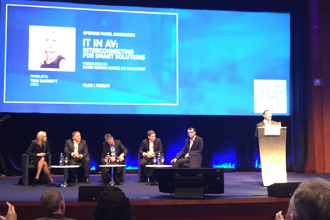Share and Share Alike: What Does the Sharing Economy Mean to AV?
 In one week of tapping away on my smartphone apps, I have ordered a ride to the airport from someone driving nearby, reserved a ski condo for a week from a private owner, found someone to pick up my dry cleaning for $5 and secured a boarding spot for my dog in a nearby home*. I am the uber consumer (yes, pun intended) of the shared economy, where underused assets are shared (access v. ownership), and the transaction is usually facilitated through the use of technology. This form of trade involves a heavy reliance on peer regulation/review and the assets involved are generally expensive to buy, or difficult to access. It is a collaborative process of mutual benefit to both parties that creates efficiency by cutting down on waste. Fueled by the tenets of sustainability, community and collaboration, this model of trade perfectly mirrors the greatest social trends of the current era.
In one week of tapping away on my smartphone apps, I have ordered a ride to the airport from someone driving nearby, reserved a ski condo for a week from a private owner, found someone to pick up my dry cleaning for $5 and secured a boarding spot for my dog in a nearby home*. I am the uber consumer (yes, pun intended) of the shared economy, where underused assets are shared (access v. ownership), and the transaction is usually facilitated through the use of technology. This form of trade involves a heavy reliance on peer regulation/review and the assets involved are generally expensive to buy, or difficult to access. It is a collaborative process of mutual benefit to both parties that creates efficiency by cutting down on waste. Fueled by the tenets of sustainability, community and collaboration, this model of trade perfectly mirrors the greatest social trends of the current era.
First of all, lest you think it’s a fad, a PricewaterhouseCoopers report suggests that the global revenue from the sharing economy could hit US$335billion by 2025. P2P sharing is already a big business at US$15billion, but when businesses begin to connect through the sharing economy, we should see that number rise significantly. Currently, the sharing economy is largely a function of P2P, but it begs the question, what are the indications for a B2B sharing economy… and, further, the AV industry?
Some of the current trends in the B2B sharing economy easily translate to the AV industry. For instance, think of the hot trend of co-working spaces such as LiquidSpace, where freelancers, home-based business owners, telecommuters and other independent workers can pay an hourly, daily or monthly subscription for office or meeting space. This has been a boon for underused office space while the renter also often enjoys networking and front office services. Imagine how this could translate to AV capabilities. Imagine if the database of clients who had available telepresence, TV studio or other high-end, professional AV application was searchable to a community of users. This could be a powerful and useful exchange.
Labor is another hot area where there is great potential for the AV industry. For example, imagine having the ability to skip a labor broker or temp agency and simply find freelance talent akin to the Elance or experience. What about a marketplace to list projects that require collaboration/partnering?
In the staging business, I frequently searched for open cargo space on semi trucks – generally because of a focus on sustainability, but that is certainly a hallmark of the sharing economy. Platforms such as Cargomatic automate a process that used to take me two hours of calls and emails to find space in local delivery trucks.
How about a popup retail space for an AV demo? Storefront is the Airbnb of retail shops, allowing for daily/weekly rental of unused retail space. Have a 3D printer? Maybe a network of 3D printers becomes small-run manufacturing. The list goes on and on… and it’s a fun one to daydream about!
The implications for the sharing economy are massive. It is estimated that every car-sharing vehicle reduces car ownership by 9-13 vehicles: a revenue loss of at least $270,000 to an average auto manufacturer. What does this mean to an AV company? For stagers, UK startup Showslice is connecting event organizers with similar event needs to share resources. On the one hand, it might be viewed as a threat if you were ousted by another AV company. On the other, it’s potentially an opportunity to keep your equipment working more days without additional labor needs. Overall, the best strategy is always to be armed with more information and prepare for fundamental changes in how your clients source and purchase.
*The apps I used were Lyft, Airbnb, taskrabbit and DogVacay… check them out!





